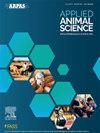Random metaphylactic effects of tulathromycin on health outcomes, complete blood count, antimicrobial use, growth performance, and Salmonella enterica shedding in high-risk beef steers
IF 1.5
Q3 AGRICULTURE, DAIRY & ANIMAL SCIENCE
引用次数: 0
Abstract
Objective
We evaluated the effects of random metaphylaxis administered with tulathromycin at feedlot arrival to 0%, 33%, 66%, and 100% of high-risk beef steers on health outcomes, growth performance, complete blood cell count, Salmonella shedding, and antimicrobial use during a 35-d receiving period.
Materials and Methods
Crossbred beef steers (n = 232; arrival BW = 213 ± 6.3 kg) were used in a generalized complete block design consisting of 2 source blocks, each with 4 BW blocks and 4 treatments. Steers were randomly assigned to pen within source block, and experimental treatments were (1) negative control, s.c. injection with sterile saline (0M); (2) tulathromycin administered at random to 33% of steers within a pen (33M); (3) tulathromycin administered at random to 66% of steers within a pen (66M); or (4) conventional metaphylaxis with tulathromycin administered to 100% of steers within a pen (100M). Body weight, whole blood, and fecal samples were collected on d 0, 14, and 35. Metaphylactic treatment was included in the model as a fixed effect, and BW block within source block was included as a random effect.
Results and Discussion
Initial bovine respiratory disease treatments were 108% and 62.2% greater for 0M and 33M, respectively, compared with the average treatment prevalence for 66M and 100M steers. No differences were detected between treatments for BW, ADG, DMI, or G:F from d 0 to 35 with dead cattle excluded or included. Hematology metrics were mostly affected by day, though reticulocyte count and eosinophil percentage differed among treatments. Fecal Salmonella concentration and prevalence did not differ among treatments but increased from d 0 to 14 before equalizing through d 35.
Conclusions and Applications
These data suggest that metaphylaxis can be administered to 66% of cattle without increasing bovine respiratory disease morbidity or decreasing growth performance. Moreover, random metaphylaxis to 66% of steers at arrival decreased the amount of active drug compound administered compared with 0M and the number of antimicrobial injections administered in each pen compared with 100M. Salmonella shedding was not affected by random metaphylaxis with tulathromycin in high-risk beef steers.
图拉霉素对高危肉牛健康结局、全血细胞计数、抗菌药物使用、生长性能和肠沙门氏菌脱落的随机过敏性影响
目的:在35天的接受期内,我们评估了0%、33%、66%和100%的高风险肉牛在到达饲养场时随机使用图拉霉素对健康结局、生长性能、全血细胞计数、沙门氏菌脱落和抗菌药物使用的影响。材料与方法杂交肉牛(n = 232;到达体重= 213±6.3 kg),采用广义完整区设计,由2个源区组成,每个源区有4个体重区和4个处理。实验处理为:(1)阴性对照,sc注射无菌生理盐水(0M);(2)在一个圈内(33M)随机给33%的牡牛施用图拉霉素;(3)在围栏内(66M), 66%的牡牛随机使用图拉霉素;(4)在100米范围内对100%的牛进行常规过敏反应,给予图拉霉素。于第0、14和35天采集体重、全血和粪便样本。变态反应治疗作为固定效应纳入模型,源块中的体重块作为随机效应纳入模型。结果与讨论0M和33M的牛呼吸道疾病初始治疗率分别比66M和100M的平均治疗率高108%和62.2%。在排除或纳入死亡牛的情况下,从0日龄到35日龄的BW、ADG、DMI或G:F处理之间没有发现差异。血液学指标主要受白天的影响,尽管网织红细胞计数和嗜酸性粒细胞百分比在治疗之间存在差异。粪便沙门氏菌浓度和流行率在不同处理之间没有差异,但在第0 ~ 14天增加,到第35天趋于平衡。结论和应用这些数据表明,过敏反应可用于66%的牛,而不会增加牛呼吸道疾病的发病率或降低生长性能。此外,66%的小鼠在到达时发生随机过敏反应,与0M相比,给药活性化合物的量减少了,与1 m相比,每个笔给药抗菌注射的次数减少了。在高危肉牛中,随机过敏反应不影响沙门氏菌的脱落。
本文章由计算机程序翻译,如有差异,请以英文原文为准。
求助全文
约1分钟内获得全文
求助全文

 求助内容:
求助内容: 应助结果提醒方式:
应助结果提醒方式:


